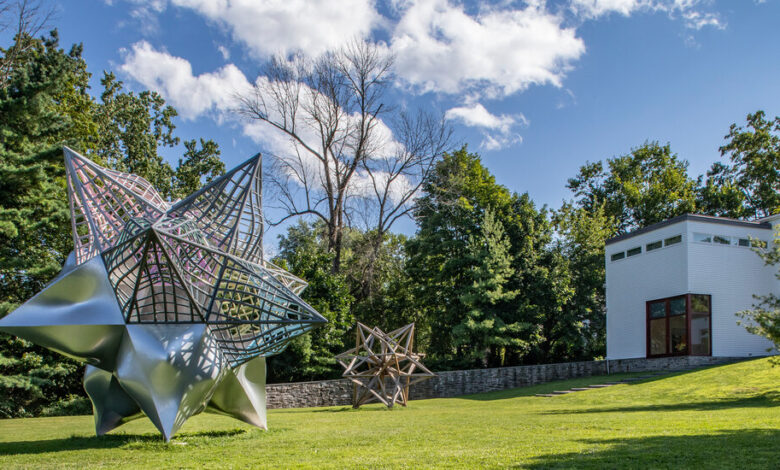Ridgefield, Conn.: Arts, Culture and Open Space

Few people embody the romance of Manhattan more than Daniel C. Levine and Bryan Perri. Mr. Levine began acting on Broadway in the mid-1990s, appearing in hits like “Les Miserables” and “Mamma Mia!” Mr. Perri, a Broadway music director and conductor, led the orchestra for “Wicked” for five years and is now attached to the Alanis Morissette musical “Jagged Little Pill.”
Yet the couple, who are married, found magic in the air some 60 miles northeast of Times Square — in Ridgefield, Conn., the arts-centric town that butts up against Westchester County in New York.
In 2016, they took up permanent residence in Mr. Levine’s weekend house in Ridgefield, a 1942 cottage that once belonged to Jolie Gabor, the mother of Zsa Zsa, Eva and Magda Gabor. “It’s set upon a hill in a clearing in the woods,” Mr. Levine said, adding that the condition required them to “renovate the hell out of it.”
Three years ago, he helped found ACT (A Contemporary Theatre) of Connecticut, a fount of classics like “Evita” and “Godspell,” as well as new productions. Mr. Levine, 49, is the artistic director, and Mr. Perri, 42, is the music supervisor. The 182-seat theater is in a reconstituted building on the former campus of the Schlumberger research laboratory, which Ridgefield acquired in 2012.
ACT is Ridgefield’s first Equity theater, but not its only performing-arts spot. The 21-year-old Ridgefield Playhouse typically puts on more than 300 one-night shows a year, including concerts and comedy acts, while the Ridgefield Theater Barn is embarking on a 4,800-square-foot expansion of the former dairy barn that has been its home for more than half a century.
This lake-dappled town of 25,000 in Fairfield County also has its own contemporary-art museum (the Aldrich), history museum (Keeler Tavern Museum and History Center), nonprofit first-run cinema (Prospector Theater), symphony orchestra and dance conservatory. ACT’s conjoined neighbor is a Philip Johnson building that the architectural and interior design studio BassamFellows pristinely renovated as its headquarters. (The building is open for gawking, with its exhibition of masterworks of modern design on view by appointment through Sept. 4.)
Jennifer Rose DiLaura, the chair of the Ridgefield Arts Council, identified more than 20 creative nonprofit arts groups in all, noting that “the beauty of this town and its organizations is its collaborative spirit.”
In April, Ridgefield became the first municipality in Connecticut to have a designated “cultural arts district,” which covers a portion of its picturesque Main Street and nearby areas.
“Westport was a little upset that Ridgefield was the first to be recognized, but our people worked very hard at it,” said Rudy Marconi, who has served for seven consecutive terms as the town’s first selectman.
The arts are the “engine that drives our community,” he said. “When you combine arts and culture with a good school system, open space trails and a beautiful Main Street, there is not a lot left to do.”
When, in the 1950s through the ’70s, Ridgefield became a bedroom community to corporations that spread into the suburbs, it changed from a place of socioeconomic diversity into one of almost uniform prosperity. The acquisition in 2012 of the 45-acre Schlumberger campus provided land for a housing development at the center of town with 54 units, 45 of which were priced in the low- to mid-$400,000s and were snapped up immediately. A few other multifamily developments followed, but Ridgefield currently offers mostly single-family homes with a median list price of $925,000.
Greater economic diversity, Mr. Marconi said, is “happening slowly but surely.” He sees an opportunity to build moderately priced housing near the town’s rail station in Branchville, on the east side of town. Creating a transit-oriented development would not only diversify the housing stock but reduce car dependence and open job opportunities for commuters to cities like Stamford and Norwalk along the train line. “The holdup is sewage,” he said.
What You’ll Find
Ridgefield’s 35 square miles shade from forested hills to equestrian stretches to lake communities with converted summer cottages to suburban shopping areas with chain stores. But the town’s Main Street — lined with towering maples and historic houses, and hung with overflowing flower baskets in summer — is its most identifiable feature and biggest lure.
Peggy Marconi, an agent with Neumann Real Estate in Ridgefield, who is married to the first selectman, said in her 24 years of selling houses, some two dozen people have shown up at her office, seized by the urge to buy in Ridgefield after driving down Main Street for the first time. (Such encounters, she said, often occurred after a wife ordered her husband to “find a place to park; this is where we’re moving.”)
“I couldn’t understand why anyone would pay Westchester taxes compared to Ridgefield,” said Sarah Patterson, an agent with Coldwell Banker, referring to property taxes that can be double what is found east of the New York-Connecticut state line. “Just drive down Main Street and take a look at it. Now people have caught on and there is that influx.”
The downtown area offers convenience to shops, restaurants, museums and parkland.
Karen and Rich Calo, retired human resources executives at IBM who have lived in Ridgefield for 35 years, most recently in the semirural Ridgebury section about six miles northwest of downtown, imagined a lifestyle with easier access to shops and services, and less property maintenance. They looked for a condo as far from plain vanilla as they could find, and discovered one on Main Street.
Their new house, in the Elms development, dates from 1760 and was operated as a tavern from 1799 to 2013. “Rich and I remember having eaten here,” Ms. Calo said. It is set near a converted 18th-century inn and a cluster of new townhouses, across the road from Ballard Park, which offers twice-weekly free concerts in the summer, and down the street from the Ridgefield Library and neighboring Prospector movie theater. (The library received an addition in 2018 that enlarged it to 44,000 square feet; the Prospector was founded in 2014, and 75 percent of its employees self-identify with a disability.)
Ridgefield also has five “recreation communities,” including Westmoreland, Mimosa Estates and West Mountain Estates, which were developed on former private estates and farmland, and offer residents community pools and tennis courts. (Homeowner association fees range from $500 to $2,000 a year, Ms. Marconi said.)
Some of the best deals are found in the small houses in Ridgefield’s lake communities, with access to recreation areas and water sports, real estate agents said. A 1959 cottage at Rainbow Lake, about five miles north of downtown, is currently on the market for $449,00, with annual taxes of $6,997. A three-bedroom ranch house, built in 1970 on nearby Fox Hill Lake, is asking $410,000, with taxes of $6,521.
Ridgefield also has three condo complexes for residents 55 and older, as well as an 86-unit assisted-living community on the former Schlumberger property. Founders Hall is the town’s donor-supported senior center, offering fitness classes, social events, academic courses and lectures, much of it free to the 3,320 active members.
Though the arts are prominent, they do not eclipse interest in sports, residents said, as has been evident by the attention showered on Kieran Smith, the 21-year-old Ridgefield native who won a bronze medal swimming the 400-meter freestyle at the Tokyo Olympics. The town offers a recreation center with a wellness center, a skate park and a 25-yard-long pool. An all-inclusive family membership for residents costs $1,023 a year.
What You’ll Pay
In July, the median sale price of Ridgefield homes was $835,000, an increase of 8 percent since February, according to information provided by Karla Murtaugh Homes. Homes sold at an average of 2 percent over asking price, compared with a sale-to-list price of 99 percent six months ago.
“Historically, we’re very light on inventory,” said Tim Dent of Coldwell Banker, who noted that in a “normal market” one could expect anywhere from 220 to 360 active listings. The number dropped to the low 30s during the worst of the pandemic and now stands in the 70s.
As of Aug. 10, listings ranged from a one-bedroom, 943-square-foot condo at the Fox Hill development, priced at $204,990 with a monthly homeowner fee of $466 and annual taxes of $2,845, to a six-bedroom, 11,697-square-foot equestrian “mini-estate” in the Ridgebury area, priced at $4.7 million, with annual taxes of $61,783.
The Vibe
Ridgefield’s allure is laid out in the tale of Liz Bronkesh Beebe and JD Beebe, a couple in their 30s who have two daughters under 2 and a pit bull. When the pandemic hit and the walls began closing in on their Harlem apartment, they lit out for Ridgefield, where Mr. Beebe was raised.
“We started looking at more commuter-friendly towns, but we weren’t finding what we really wanted,” said Mr. Beebe, who runs his start-up company, ThankView, from home and plans eventually to commute to New York City twice a week, at most. (“I pity the fool that does that every day,” he said). “Ridgefield, with so many restaurants and the theater, the two theaters, the movie theater — the downtown is bustling in a way I don’t remember, growing up.”
The Schools
In the 2020-21 school year, the Ridgefield school district served 4,867 students at six elementary schools, two middle schools and Ridgefield High School. The student body was 82 percent white, 7 percent Hispanic, 6 percent Asian and 1 percent Black. Among students who opted to take state tests, 86 percent met standards in reading, versus 58 percent statewide; 78 percent met standards in math, versus 47 percent statewide. The district spends an average of $22,107 per student, compared with the state median of $20,069.
In its 2021 survey, U.S. News & World Report ranked Ridgefield High School eighth in Connecticut, based on its 99 percent graduation rate and Advanced Placement program (the school offers 20 A.P. courses, and 61 percent of students passed at least one A.P. exam), among other metrics.
The Commute
Because Ridgefield’s Branchville station runs most of its trains through Stamford, commuters to New York City often opt for a direct Metro-North line from Katonah or Goldens Bridge in New York. A shuttle bus runs from Jesse Lee Church on Main Street to Katonah station at 6:41 a.m. on weekdays. The trip from Katonah to Grand Central Terminal takes between an hour and 90 minutes; a monthly pass is $384.
The History
In December 2019, construction workers renovating an early-18th-century house discovered the skeletal remains of four men who may have perished in the Revolutionary War clash known as the Battle of Ridgefield. The battle took place on April 27, 1777, when Continental Army generals, including Benedict Arnold, led 700 militiamen and regulars in an attack of British troops who had just blown up an inland supply depot and were returning to their ships on Long Island Sound.
For weekly email updates on residential real estate news, sign up here. Follow us on Twitter: @nytrealestate.






